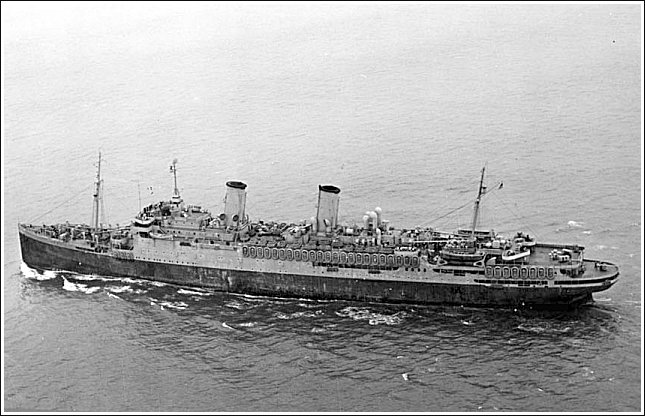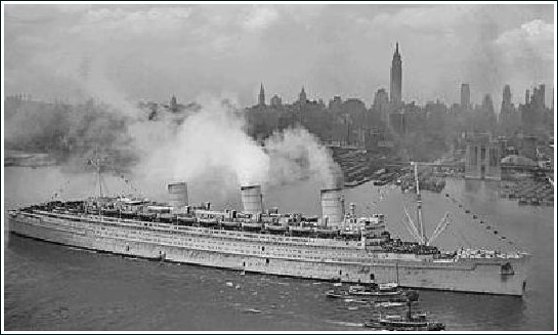|
463rd Parachute Field Artillery Battalion Troops Returning USA Credit A lot of gratitude towards WW2 D Battery Mr.
Ken HESLER for the research. Introduction As explained in the monthly narrative pages under the “War’s End and Beyond” heading in the “463rd PFA” section of this website, the battalion’s inflow and outflow of troops following war’s end was based largely on E.T.O. command decisions as to how to retain units and personnel available for Pacific operations, if necessary, and how to return troops to the United States for redeployment or separation from the service, based largely on the point system. (Please see the information on “Point System”) below.
For example, 17th Airborne Division artillery personnel with fewer points came to the battalion to replace 463rd soldiers with higher numbers who then went to the 17th Airborne for redeployment home. Similar movements occurred between the battalion and the 82nd Airborne Division, and other units.
Principal departure centers for USA bound 463rd troops were Le Havre and Marseilles, France. Departures under the point system began as early as March 1945, increasing after the German and Japanese conflicts had ended and concluding by early 1946.
Major USA ports for E.T.O. troop arrivals were on the east coast, but only database lists of military passengers arriving in New York (June 1945 or later) are easily available. Two of those carrying significant numbers of 463rd troops were the U.S.S. Monticello arriving June 26, 1945, and the Queen Mary, arriving January 3, 1946. Others returned through Boston.
Most of the 463rd troops on the Queen Mary had transferred to the 82nd Airborne Division in Europe as members of the 456th Parachute Field Artillery Battalion, ironically the parent unit of the 463rd, and who planned to continue their military careers.
U.S.S. Monticello (AP61)
Arrive : New York from Le Havre, France, June 26, 1945, departing
June 19, 1945
Ken Hesler: "This is the U.S.S.
Monticello, but the photo is from another crossing. I believe that I found all the names
that I could identify from my roster, but I cannot be sure. Other troops departing Europe
(including Marseille, France) landed at Boston and other ports
463rd Passengers:
QUEEN MARY Arrive : New York, January 3, 1946, from from Southampton (United Kingdom)
The R.M.S Queen Mary at War time.
List explained:
- the number between brackets is probably just a manifest number - ASR: Adjusted Service Rating (or the POINT system). This is explained a little further on this page). - ASN: Army serial number (there might be some typo's here, apologies...) - MOS: Military Occupation Specialty (there is a list a little further on this page.) - 'mos sv': not sure what that is...
456th/463rd Passenger List:
The ASR (Adjusted Service Rating) better known as the "POINT SYSTEM" Adjusted Service Rating (ASR) is the “Point System” as initially
proposed by General George C. Marshall, and amended by Secretary of
War Henry L. Stimson on May 10, 1945 (introduced May 12) . The
Adjusted Service Rating Score (ASRS), was based on the “Point
System”, whereby a soldier was awarded a number of Points for his
months of service, for the medals he received, for the combat stars
earned by his unit, and for the number of children he had … the
higher the score, the higher the probability to be sent home for
demobilization and discharge ! ”Points” for discharge from the Army
were to be totaled as follows :
After V-J Day, the Critical Score was already down to 80 Points,
and in response to political pressures (Bring the Boys home !)
repeated downward revisions were to follow. Critical scores were set
for Army Ground Forces, Army Service Forces, Army Air Forces,
Women’s Army Corps, holders of the Medal of Honor, and married
members of the WAC .
Meanwhile ‘green’ troops from US Training Centers would
arrive to replace the departing Veterans ! Confusion did result from
its application, and transfer, and redeployment did not always take
place as foreseen or planned … loss, departure, replacement, normal
attrition, would seriously compromise some essential services in the
E.T.O. … by end of September Critical Scores for Medical Officers, received by end May 1945,
varied with the Corps – for Hygienists and Dietitians the figure was
62 Points, for Physical Therapists, 65, for Nurses, 71, for MAC
Officers, 88, and for MC Officers, 85 and plus (according to
Specialty) . The overall program was usually carried out faithfully
until end July 1945, but by that date, demands for shipping to move
men & equipment to the Pacific were so great as to preclude movement
of Medical units to the United States for inactivation and
disbandment . Therefore it was decided to inactivate Category IV
units in the By 1 December 1945, a new policy applied whereby servicemen would
be eligible for Discharge based on a combination of ASR score and
length of service ! All Enlisted fathers with 3 or more Children (under 18 Years of
Age) were immediately eligible for Discharge, irrespectively of
their length of Service . U.S. Army World War II Military Occupational Specialties (By Number) - WWII MOS Number
Military Occupational Classification is the awarding of an
M.O.S. number based on all pertinent data concerning ability,
education, training, intelligence, aptitude, occupational history,
interests, personal traits, military experience, and other
demonstrated qualifications – such information will be clearly
recorded so that each individual’s skills will be evaluated Of all provisions of the Army’s Classification System those concerned with occupational skills were the most elaborate and the most refined ! The Army sought to meet its needs for specialists with men experienced in related occupations in civilian life. The purpose was the very important one of speeding up Mobilization and Training by utilizing the full capacities of the available manpower . Specialists, in this connection, included those pursuing relatively simple trades which could be learned in a few weeks or months – the need of the Army for specialists was made clear to the public, especially in the period before the Declaration of War, when the distastefulness of compulsory Military Training could be relieved by pointing out its vocational value . The publicizing of technical requirements produced an expectation among many Inductees that they could best contribute to the war effort by continuing with their usual occupations, somewhat modified, in the Army ! The satisfaction or disappointment of these expectations became an important factor in morale.
At the Reception Center the newly inducted man, after passing
an interview, with or without vocational tests, was classified
according to his occupational experience or aptitude – he received
the SSN (Specification Serial Number) most closely
corresponding to his main civilian skill . This number inevitably
fell in the group below 500 ! To fill the need for
In order to improve occupational classification in general, a series
of Military Occupational Specialty (MOS) Tests were
introduced (before end 1944) for all services in the Army Ground
Forces (AGF) – they usually consisted of 2 principal parts : (1)
questions covering the character of the duties required of the
individual, and (2) practical
List of MOS numbers:
Bibliography: TM 12-427: Military Occupational Classification of Enlisted Personnel – (12 July 1944)
|
|||||||||||||||||||||||||||||||||||||||||||||||||||||||||||||||||||||||||||||||||||||||||||||||||||||||||||||||||||||||||||||||||||||||||||||||||||||||||||||||||||||||||||||||||||||||||||||||||||||||||||||||||||||||||||||||||||||||||||||||||||||||||||||||||||||||||||||||||||||||||||||||||||||||||||||||||||||||||||||||||||||||||||||||||||||||||||||||||||||||||||||||||||||||||||||||||||||||||||||||||||||||||||||||||||||||||||||||||||||||||||||||||||||||||||||||||||||||||||||||||||||||||||||||||||||||||||||||||||||||||||||||||||||||||||||||||||||||||||||||||||||||||||||||||||||||||||||||||||||||||||||||||||||||||||||||||||||||||||||||||||||||||||||||||||||||||||||||||||||||||||||||||||||||||||||||||||||||||||||||||||||||||||||||||||||||||||||||||||||||||||||||||||||||||||||||||||||||||||||||||||||||||||||||||||||||||||||||||||||||||||||||||||||||||||||||||||||||||||||||||||||||||||||||||||||||||||||||||||||||||||||||||||||||||||||||||||||||||||||||||||||||||||||||||||||||||||||||||||||||

